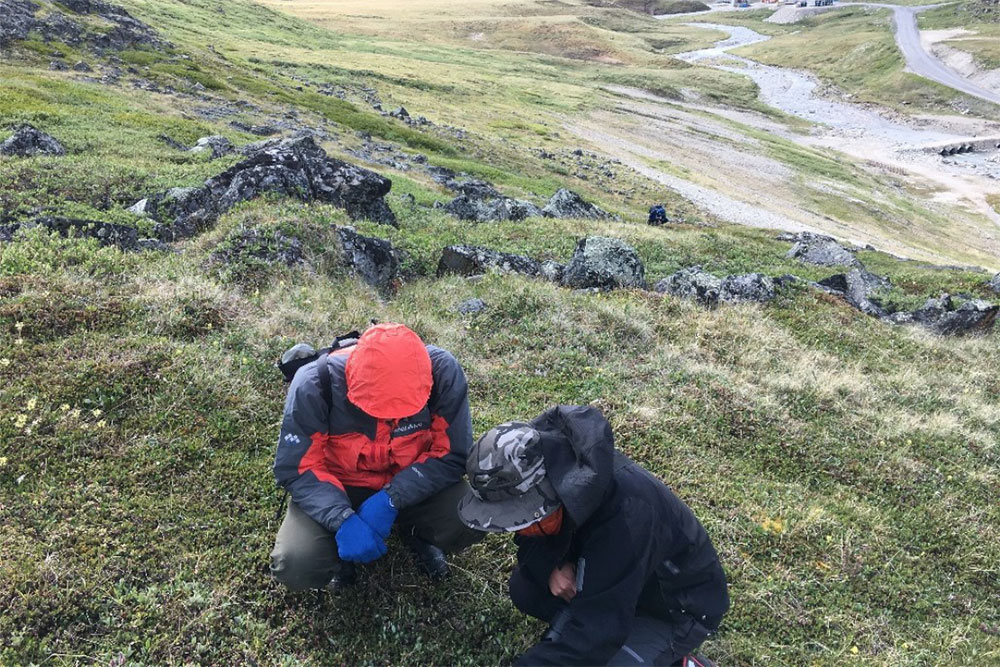National Institute of Polar Research
Plant life determines soil bacteria diversity in the Arctic tundra
Published on May 10, 2023
Posted on June 24, 2023
Living and nonliving factors that influence the types of vegetation that grow at different elevations in the Arctic tundra also regulate the types of bacteria that grow in the soil. The distribution of generalist bacteria, which can adapt to a broader range of environmental conditions, ultimately determines the populations and variety of other bacteria inhabiting the soil ecosystem in this extreme environment.
Scientists recently completed an in-depth study identifying the relationships between different soil bacteria at three different elevations (topography) in the Arctic tundra in Salluit, Canada (Figure 1), and created a model summarizing how these different bacteria are affected by vegetation and environmental conditions, such as temperature, moisture level, and carbon or nitrogen content.
The team published the results of their study in the May 10 issue of the journal Environmental Microbiome.

Figure1: View of the sampling area in Salluit located on the Low Arctic Tundra.
“Understanding how vegetation and other factors interact with microbial communities can help us gain important insights into the functioning of Arctic ecosystems and better predict how they will respond to environmental change,” said Shu-Kuan Wong, first author of the study and postdoctoral researcher at the Research Organization of Information and Systems in the National Institute of Polar Research in Tokyo, Japan.
The research team designed their study to answer three fundamental questions: Which soil bacteria could be classified as generalists or specialists based on their ability to adapt to their environment, how do generalist and specialist microbes influence the other microorganisms surrounding them, and how sensitive are bacteria to variations in the environment?
The extreme conditions of the Arctic tundra make it difficult for trees to grow, creating a harsher environment for soil microorganisms. With conditions warming in the Arctic with climate change, a more complete understanding of soil ecosystem dynamics was needed to predict changes in Arctic tundra soil microbial diversity as the planet warms.
“This research sheds light on how vegetation plays the main role in shaping different microbial groups in the low Arctic tundra,” said Wong. The team found that vascular plants were prominent at lower elevations in the Arctic tundra, and cryptogams, or plants like lichens that lack true flowers or seeds, were more prominent at higher elevations. Plant coverage, in turn, directly regulated the presence or absence of different generalist bacteria and indirectly affected the dynamics of common bacteria and specialist bacteria.
“Generalists, which could tolerate a wider range of environmental conditions, were closely linked to the distribution of vascular plants and… acted as ‘bridge species’ that connected and tied other microbial communities together. Specialists had a more restricted distribution and made selective connections with other microbes within the same niche, [or ecological role],” said Wong (Figure 2).

Figure2: Summary of the biotic (living) and abiotic (non-living) interactions in the Low Arctic Tundra of Salluit.
Changes in environmental factors, such as temperature, due to climate change will inevitably affect the Arctic tundra's soil ecosystem. “As climate change progresses, vegetation changes. Our research suggests that this would impact the generalists [bacteria]. A harsher climate would [also] further restrict the already ‘sensitive’ specialists [bacteria],” said Wong. These changes in generalists’ and specialists’ distribution and diversity could significantly impact the Arctic ecosystem by affecting plant-soil interactions.
While this research greatly improves the modeling of bacterial communities in the soil of the Arctic tundra, the team acknowledges that their study captures only a small area and that more variables may be present in a study encompassing a more extensive range. “Future work will focus on studying how different soil microbial groups interact with their surrounding environment at a larger regional scale. Gaining a more comprehensive understanding of Arctic ecosystem dynamics can help to better predict how these ecosystems will respond to future environmental changes,” said Wong.
Other contributors include Yingshun Cui and An Suk Lim from the Division of Life Science and Plant Molecular Biology and Biotechnology Research Center at Gyeongsang National University in Jinju, Korea; Seong-Jun Chun from the LMO Team at the National Institute of Ecology, 1210 in Seocheon, Republic of Korea; Ryo Kaneko from the Research Organization of Information and Systems at the National Institute of Polar Research in Tokyo, Japan; Shota Masumoto and Akira S. Mori from the Graduate School of Environment and Information Sciences at Yokohama National University in Yokohama, Japan; Ryo Kitagawa from the Kansai Research Center, Forestry and Forest Products Research Institute in Kyoto, Japan; and Masaki Uchida from the Research Organization of Information and Systems at the National Institute of Polar Research in Tokyo, Japan and the Department of Polar Science in the School of Multidisciplinary Sciences at the Graduate University for Advanced Studies, SOKENDAI, in Tokyo, Japan.
This work was supported by the Arctic Challenge for Sustainability (ArCS; program grant number: JPMXD1300000000), Arctic Challenge for Sustainability II (ArCS II; program grant number: JPMXD1420318865), programs of the Ministry of Education, Culture, Sports, Science, and Technology Japan, JSPS KAKENHI (Grant Number: JP18H03413), and the National Institute of Ecology (NIE) funded by the Ministry of Environment (MOE) of South Korea (Grant Number: NIE-A-2023–10).
Original article:
Journal: Environmental Microbiome
Title: Vegetation as a key driver of the distribution of microbial generalists that in turn shapes the overall microbial community structure in the low Arctic tundra
Authors:
Shu-Kuan Wong (National Institute of Polar Research, Japan)
Yingshun Cui (Gyeongsang National University, Korea)
Seong-Jun Chun (National Institute of Ecology, Korea)
Ryo Kaneko (National Institute of Polar Research, Japan)
Shota Masumoto (Yokohama National University, Japan)
Ryo Kitagawa (Forestry and Forest Products Research Institute Japan)
Akira S. Mori (Yokohama National University, Japan)
An Suk Lim (Gyeongsang National University, Korea)
Masaki Uchida (National Institute of Polar Research, Japan)
DOI: 10.1186/s40793-023-00498-6
URL: https://environmentalmicrobiome.biomedcentral.com/articles/10.1186/s40793-023-00498-6
Published: May 10, 2023








